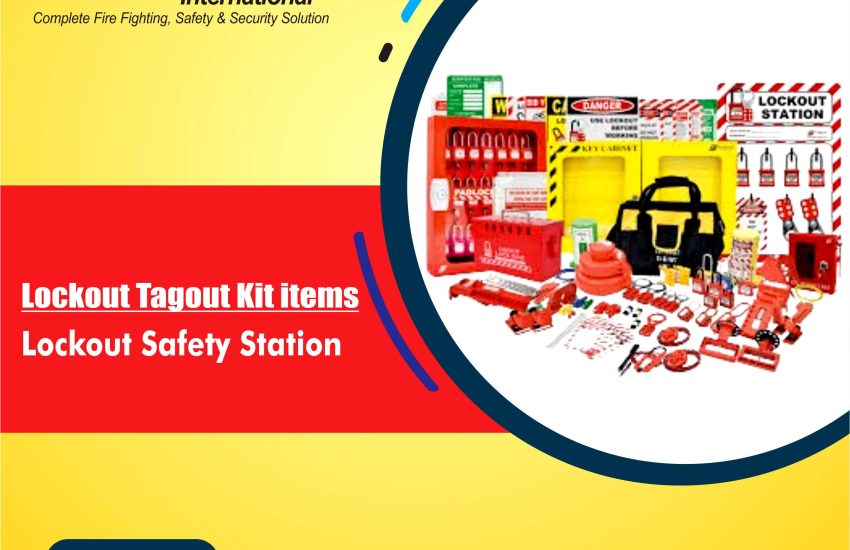Lockout Safety Station Workplace safety is a top priority for all industries, especially in environments where employees handle hazardous machinery or equipment. One of the most critical safety measures is ensuring that employees follow proper lockout/tagout (LOTO) procedures during maintenance and repair work. A Lockout Safety Station plays a vital role in helping workers follow these procedures. This guide explains the importance of Lockout Safety Stations, their components, benefits, and how to implement them effectively in your workplace.
What is a Lockout Safety Station?
A Lockout Safety Station is a designated area within the workplace that holds all the necessary tools, equipment, and information to carry out lockout/tagout procedures. It helps workers safely and quickly implement lockout/tagout protocols when servicing machinery or equipment. The station typically contains:
- Lockout tags
- Padlocks and keys
- Hasps
- Lockout devices
- Personal protective equipment (PPE)
- Lockout/tagout procedure manuals
- Safety guidelines and labels
These stations keep lockout/tagout materials organized and easily accessible, promoting safety and ensuring compliance with OSHA (Occupational Safety and Health Administration) regulations.
Why Lockout Safety Stations Are Essential
Lockout Safety Stations provide many benefits, helping your workplace maintain safety and regulatory compliance:
1. OSHA Compliance
OSHA requires employers to implement lockout/tagout procedures to protect employees from hazardous energy during maintenance. A well-organized Lockout Safety Station ensures compliance with OSHA standards, helping you avoid fines and accidents.
2. Centralized Access
A Lockout Safety Station provides a central location for lockout/tagout tools and materials, allowing workers to quickly find everything they need. This improves efficiency, reduces downtime, and ensures workers follow safety protocols.
3. Promotes Safety
A Lockout Safety Station equips workers with the proper tools and equipment to prevent accidents caused by the accidental release of hazardous energy. These stations reinforce the importance of lockout/tagout procedures, which reduces the likelihood of injuries.
4. Enhances Organization
A dedicated station for lockout/tagout tools ensures that workers keep materials organized and easy to access. This reduces errors and helps workers find the necessary equipment for a safe lockout/tagout procedure.
Components of a Lockout Safety Station
A comprehensive Lockout Safety Station includes various components to help workers perform lockout/tagout procedures correctly. Key elements include:
1. Lockout Tags
Lockout tags are a critical component of any safety station. These tags show that equipment is under maintenance and should not be operated. Businesses can customize lockout tags to include information like the worker’s name, lockout time, and safety instructions.
2. Padlocks and Keys
Padlocks secure machinery or equipment during maintenance. The station should include various padlocks and a sufficient number of keys to ensure each lockout is unique and secure.
3. Hasps
Hasps allow multiple workers to lock out a single piece of equipment, especially in situations where more than one person is working on the same machine. A lockout hasp ensures that the equipment cannot be restarted until all workers have removed their locks.
4. Lockout Devices
Lockout devices prevent specific machinery or equipment from operating. These devices include valve covers, circuit breaker locks, or electrical plug locks. They should be readily available in the safety station.
5. Personal Protective Equipment (PPE)
Personal protective equipment such as gloves, goggles, and hearing protection should be accessible at the Lockout Safety Station. PPE ensures that workers stay protected during lockout/tagout procedures and maintenance tasks.
6. Safety Guidelines and Manuals
A comprehensive safety manual should be accessible in the station. This manual outlines the step-by-step procedures for locking out equipment, including instructions on how to handle hazardous energy sources safely.
How to Implement a Lockout Safety Station in Your Workplace
Setting up a Lockout Safety Station in your workplace is a straightforward process. Follow these steps:
- Assess Your Workplace Needs:
Evaluate the types of equipment and machinery in your facility and determine the areas where lockout/tagout procedures are necessary. This will help you decide on the size and scope of your safety station. - Select the Right Equipment:
Choose lockout/tagout materials that match the machinery in your facility. Ensure the Lockout Station includes various padlocks, tags, devices, and PPE to address different lockout situations. - Designate a Location:
Place the Lockout Station in a central, easily accessible area close to the machinery that requires lockout/tagout procedures. This ensures that workers can access the necessary tools and materials without delay. - Train Employees:
Provide comprehensive lockout/tagout training to all employees. Make sure they understand how to use the materials in the safety station properly. Training should cover the importance of lockout/tagout procedures, how to apply and remove locks, and how to communicate with other workers during the process. - Regularly Inspect and Maintain the Station:
Perform regular checks to ensure the Lockout Station remains well-stocked, organized, and in good condition. Replace damaged or missing equipment and ensure that tags and locks are legible and up-to-date.
Conclusion
A Lockout Station is an essential part of any workplace safety program. It helps ensure that employees follow lockout/tagout procedures correctly, reducing the risk of injuries and ensuring compliance with OSHA regulations. By organizing lockout/tagout tools and equipment in a central station, businesses can promote safety, improve efficiency, and protect employees from hazardous energy sources. Implementing a Lockout Station in your workplace is a crucial step toward maintaining a safe, organized, and compliant work environment.


